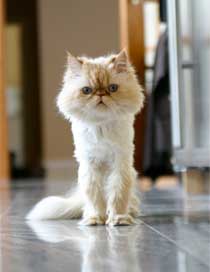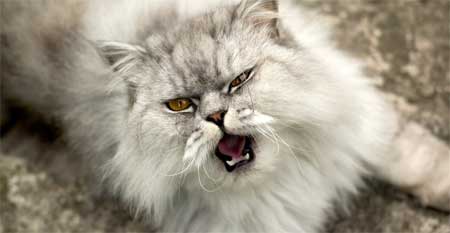|

 Just for Show: A show-quality Persian has an extremely long thick coat, short legs, a wide head with the ears set far apart, large eyes, and an extremely foreshortened muzzle. The breed was originally established with a short (but not non-existent) muzzle, but over time this feature has become extremely exaggerated, particularly in North America. Persians with the more extreme brachycelphalic head type are prone to a number of health problems (specifically affecting their sinuses and breathing). Conscientious breeders prevent these problems through careful choice of breeding stock with more moderate head types, as the goal is first and always healthy cats. Just for Show: A show-quality Persian has an extremely long thick coat, short legs, a wide head with the ears set far apart, large eyes, and an extremely foreshortened muzzle. The breed was originally established with a short (but not non-existent) muzzle, but over time this feature has become extremely exaggerated, particularly in North America. Persians with the more extreme brachycelphalic head type are prone to a number of health problems (specifically affecting their sinuses and breathing). Conscientious breeders prevent these problems through careful choice of breeding stock with more moderate head types, as the goal is first and always healthy cats.
In the USA, there was an attempt to establish the Silver Persian as a separate breed called the Sterling, but it was not accepted and Silver and Golden longhaired cats (recognized by CFA more specially as Chinchilla Silvers, Shaded Silvers, Chinchilla Goldens or Shaded Goldens) are judged in the Persian category of cat shows. In South Africa, the attempt to separate the breed was more successful: the SA Cat Council (SACC) registers cats with 5 generations of pure bred Chinchilla as a Chinchilla Longhair.
Winner by a nose: The Chinchilla Longhair has a slightly longer nose than the Persian, resulting in healthy breathing and no tearing of the eyes. Its hair is translucent with only the tips carrying black pigment: a feature that gets lost when out-crossed to other colored Persians. Out-crossing also may result in losing nose and lip liner, which is a fault in the Chinchilla Longhair breed standard.
Cats of Different Colors: Persian cats can have any color or markings including pointed, tortoiseshell, blue, and tabby. Persian cats with point are referred to as Colourpoint Persian in Europe and Himalayan (cat) in United States.

High Maintenance: Because their fur is too long and dense for them to maintain themselves, Persian cats need regular grooming. To keep their fur in its best condition, they must be bathed regularly, dried carefully afterwards, and brushed thoroughly every day. Their eyes need to be checked for problems on a regular basis because some animals have trouble keeping them clean.


A Persian cat without an established and registered pedigree is classed as a domestic longhair cat.
All text is available under the terms
of the GNU Free Documentation License
|
